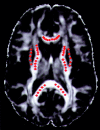Diffusion tensor MR imaging in diffuse axonal injury
- PMID: 12006280
- PMCID: PMC7974716
Diffusion tensor MR imaging in diffuse axonal injury
Abstract
Background and purpose: Disruption of the cytoskeletal network and axonal membranes characterizes diffuse axonal injury (DAI) in the first few hours after traumatic brain injury. Histologic abnormalities seen in DAI hypothetically decrease the diffusion along axons and increase the diffusion in directions perpendicular to them. DAI therefore is hypothetically associated in the short term with decreased diffusion anisotropy. We tested this hypothesis by measuring the diffusion characteristics of traumatized brain tissue with use of diffusion tensor MR imaging.
Methods: Five patients with mild traumatic brain injuries and 10 control subjects were studied with CT, conventional MR imaging, and diffusion tensor imaging. All patients were examined within 24 hours of injury. In each participant, diffusion tensor indices from homologous normal-appearing white matter regions of both hemispheres were compared. These indices were also compared between homologous regions of each patient and the control group. In two patients, diffusion tensor images from the immediate post-trauma period were compared with those at 1 month follow-up.
Results: Patients displayed significant reduction of diffusion anisotropy in several regions compared with the homologous ones in the contralateral hemisphere. Such differences were not observed in the control subjects. Significant reduction of diffusion anisotropy was also detected when diffusion tensor results from the patients were compared with those of the controls. This reduction was often less evident 1 month after injury.
Conclusion: White matter regions with reduced anisotropy are detected in the first 24 hours after traumatic brain injury. Therefore, diffusion tensor imaging may be a powerful technique for in vivo detection of DAI.
Figures






References
-
- Kraus J, Nourjah P. The epidemiology of mild head injury. In: Levin H, Eisenberg H, Benton A, eds. Mild Head Injury. Oxford: Oxford University Press;1989. :8–22
-
- Capruso DX, Levin HS. Cognitive impairment following closed head injury. Neurol Clin 1992;10:879–893 - PubMed
-
- Evans RW. The postconcussion syndrome and the sequelae of mild head injury. Neurol Clin 1992;10:815–847 - PubMed
-
- Levin HS, Mattis S, Ruff RM, et al. Neurobehavioral outcome following minor head injury: a three-center study. J Neurosurg 1987;66:234–243 - PubMed
MeSH terms
LinkOut - more resources
Full Text Sources
Medical
